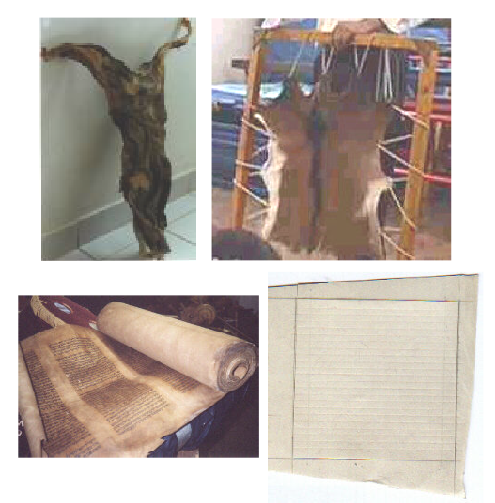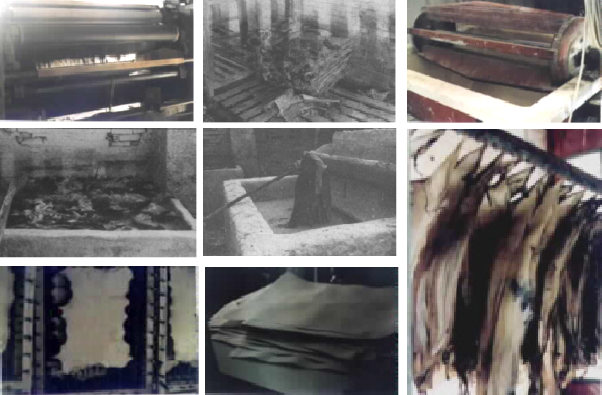
K'laf
- parchment
Parchment can be made of the specially prepared skin of a kosher animal - goat, bull/cow, or deer. The hide consist of three layers, a) g’vil, b) k’laf
and c) doksostus, but only the flesh side of the inner layer (a) and the outer side of the hairy layer (b) can be used for holy writings, (c) is not permitted. The method of cleaning and preparing the hide has changed over the centuries. During talmudic times, salt water and barley were sprinkled on the skins which were then soaked in the juice of afatsim
(gallnuts). However they even used dog’s dung for this purpose! Nowadays the skins are dipped in clear water for two days after which it is soaked in lime-water for nine days to remove the hair. When it is a hairless surface, the sofer
stretches it on a wooden drying frame and scrapes it until it is dry and creases ironed out with presses. Then it is sanded it until it becomes a flat, smooth sheet fit for writing. Some parchment (usually poor quality) is smeared with a chalky substance (log) to make it whiter (though occasionally this is only done on the reverse). However some scribes object to this as it forms a barrier between the ink and the parchment. Indeed Keset Hasofer
says we should be strict about not doing this.
Because of modern processes all parchment is now prepared to the ruling of k’laf
and used in that manner, i.e. we write on the flesh side and not on the hair side, as writing on the hair side is considered invalid.
This page uses a number of photos from other websites or books as there are no parchment makers currently at work in the UK and thus unfortunately I have not been able to provide original/clear imagery or always recall where I first found the images decades ago.
1. A roll of untreated skin. Photo courtesy of Benjamin Cohen
Sofer S”TaM z"l.
2. Treated skin being stretched on a wooden drying frame.
3. A Torah written on
g'vil.
4. One of my ruled out
mezuzah blanks.
The parchment must be prepared for the sake of heaven and the processor must make a declaration as to what he is preparing it for as one cannot use k'laf
destined for a lesser holiness (kedusha kallah) - eg a mezuzah
to write tefillin
or a Sefer Torah, which are weightier holiness (kedusha chamurah). If one has to, one should state that you are preparing for the sake of a Sefer Torah but that it is in your hand to change your mind if you so wish. If there is no Jew able to prepare the parchment then in exceptional circumstances a non-Jew may prepare it but a Jew must stand over him directing him in his work and stating that the preparation is for the sake of heaven. After preparation the scribe must mark out the parchment using the sargel
(rule) - see diary 1- ensuring the guidelines are straight. Only the top guide is done and the letters suspended from it.
The skins should be of the highest quality, from an infection free animal and free from blemishes. The skins are shaved from the animal and dried (ideally in the sun). The processes that follow differ depending on whether the preparation is done entirely manually or whether there is machine assistance.
Firstly the cow skins are fleshed removing excess tissue (in a mechanical flesher). The skins are then delivered in bundles to the parchment preparer. This raw skin then needs to be softened in order to remove unwanted tissue, soaking in water for around 24 hours. Halachically the preparation or processing has not yet begun. It is the next step that marks this. The processor needs to verbalise their intention that they are putting the skins into a strong limestone solution bath (below left) for the specific purpose of the mitsvah. This limestone solution is called sid and it is done to remove the hairs of the animal. Halachically it should remain in the solution for four days, but it can be left as long as ten.
Removal before the minimum 4 day period classes the skin as diftera and as such it is not valid for holy work. After removal from the lye-bath they are left to dry. Then they are soaked again! The wet skins are then then stretched out on wooden stretchers to thin and straighten them. They are then scraped with a curved blade to ensure that they are totally free from hair and any excess tissue. Often the edges of a sheet of k’laf will be thicker than the middle area because of the scraping. However the scraping realigns the fibres which makes writing easier and helps absorb the ink into the k’laf. After this the parchment is finally left to dry on the racks and when fully dry the skins are cut from the racks into a rectangular shapes (right) for ruling and use by the sofer.
Removal before the minimum 4 day period classes the skin as diftera and as such it is not valid for holy work. After removal from the lye-bath they are left to dry. Then they are soaked again! The wet skins are then then stretched out on wooden stretchers to thin and straighten them. They are then scraped with a curved blade to ensure that they are totally free from hair and any excess tissue. Often the edges of a sheet of k’laf will be thicker than the middle area because of the scraping. However the scraping realigns the fibres which makes writing easier and helps absorb the ink into the k’laf. After this the parchment is finally left to dry on the racks and when fully dry the skins are cut from the racks into a rectangular shapes (right) for ruling and use by the sofer.
Mordechai Pinchas
Below: a few photographs of the process gleaned form old books and websites over 25 years ago. There are better images in some of the more modern books referenced in my sources page.


